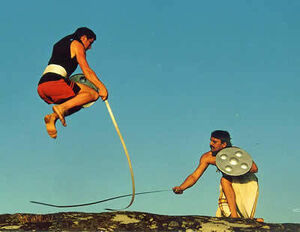No edit summary Tag: Source edit |
(→Uses) Tag: Source edit |
||
| Line 13: | Line 13: | ||
There is very little evidence to confirm if and how the weapon was used in warfare. Allegedly, this weapon's flexibility allowed it to be worn on a person like a belt, similar to [[Sling]]s. |
There is very little evidence to confirm if and how the weapon was used in warfare. Allegedly, this weapon's flexibility allowed it to be worn on a person like a belt, similar to [[Sling]]s. |
||
| + | ==Test== |
||
The weapon did not achieve any kills in the simulation with the experts stating it was more of a pain inducing weapon, and didn't have that much killing ability. It was easily stopped by shields and light armor due to its light weight and low cutting power. The expert testing it was also shown to be significantly fatigued from keeping the weapon in constant motion. |
The weapon did not achieve any kills in the simulation with the experts stating it was more of a pain inducing weapon, and didn't have that much killing ability. It was easily stopped by shields and light armor due to its light weight and low cutting power. The expert testing it was also shown to be significantly fatigued from keeping the weapon in constant motion. |
||
Revision as of 09:17, 25 September 2020

The Aara, also known as the Urumi, is a flexible sword of India. It was the Mid-Range weapon of the Rajput Warrior.
Description
The Aara has one or more flexible steel bands about 3/4 to 1 inch wide and usually between 4 to 5 1/2 feet long. The handle is small and has a cover to protect the hand. The bands are sharpened, and in modern times, they are often made from used Band-saw blades.
During the renaissance; Aara metal was basically the same metal used for clock coils except much longer and sharper.
Uses
The Aara is one of the weapons learned in the Indian martial art Kalaripayattu. Due to the danger it poses both to the opponent and user, it is taught to only the most skilled students. Agility and skill are more important in using the weapon than strength or aggression. It was useful when the user was alone and faced multiple opponents. Worn around the waist like a belt until needed, it was also an inconspicuous weapon to carry.
The region of Kerala is believed to be where this weapon originated from.
There is very little evidence to confirm if and how the weapon was used in warfare. Allegedly, this weapon's flexibility allowed it to be worn on a person like a belt, similar to Slings.
Test
The weapon did not achieve any kills in the simulation with the experts stating it was more of a pain inducing weapon, and didn't have that much killing ability. It was easily stopped by shields and light armor due to its light weight and low cutting power. The expert testing it was also shown to be significantly fatigued from keeping the weapon in constant motion.